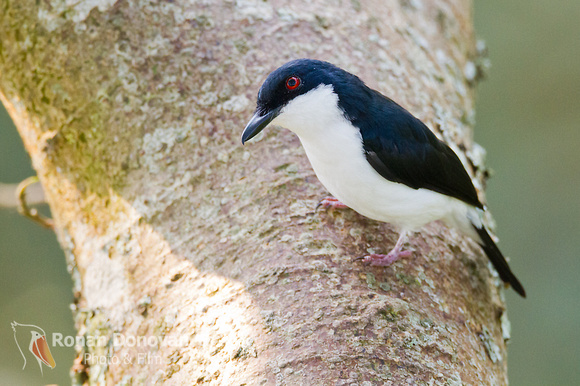
Megabyas flammulatus
SUBFAMILY
Platysteirinae
TAXONOMY
Megabyas flammulata Verreaux, 1855.
OTHER COMMON NAMES
English: African shrike-flycatcher; French: Gobemouche
йcorcheur; German: Schnдpperwьrger; Spanish: Atrapamoscas
Africano.
PHYSICAL CHARACTERISTICS
The body length is about 6 in (15 cm). The iris is bright orange.
The male is colored glossy black on the head, back,
wings, and tail, and white on the rump, underparts, and underwings.
The female and immature are brownish, and their
breast is brown-streaked on white.
DISTRIBUTION
A widespread, nonmigratory species of central tropical Africa.
HABITAT
Occurs in lowland, humid, primary and mature secondary tropical
forest, as well as the forested edges of clearings. It occurs
as high as about 7,000 ft (2,150 m)
BEHAVIOR
A nonmigratory species that occurs in pairs or small groups.
Breeding birds defend a territory. Sits quietly on a perch, often
swinging its tail slowly sideways. The song is a sustained series
of repetitive phrases.
FEEDING ECOLOGY AND DIET
Searches actively or from a perch for flying insects in the lower
part of the forest canopy. Insects are also gleaned from foliage.
Sometimes joins mixed-species foraging flocks.
REPRODUCTIVE BIOLOGY
Builds a small cup-shaped nest in a narrow fork of a branch.
Lays two or three, greenish-gray, mottled eggs that are incubated
for at least 16 days. Pairs are monogamous but are probably
helped with their breeding by their immature progeny.
CONSERVATION STATUS
Not threatened. An endemic species that is locally abundant in
parts of its range.
SIGNIFICANCE TO HUMANS
None known, except for the economic benefits of birdwatching.
Photo Gallery of - Shrike-flycatcher




 Animalia Life
Animalia Life